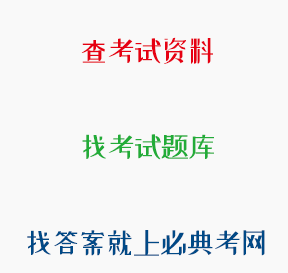正确答案: D
清明节一一风雨端阳生晦冥,汨罗无处吊英灵。
题目:下列选项中,诗句与所描写的节日对应不正确的是( )。
解析:"风雨端阳生晦冥,汨罗无处吊英灵"描绘的是屈原投水汨罗江,是端午节的典故。与清明有关的诗句有"清明时节雨纷纷,路上行人欲断魂";"风光烟火清明日,歌哭悲欢城市间"。故选择D。
查看原题 查看所有试题
学习资料的答案和解析:
[单选题]依据《中华人民共和国预防未成年人犯罪法》,下列选项中,学校应当及时与其父母或法定监护人取得联系的学生行为是( )。
多日旷课
解析:《中华人民共和国预防未成年人犯罪法》第十六条规定,中小学生旷课的,学校应当及时与其父母或者其他监护人取得联系。未成年人擅自外出夜不归宿的,其父母或者其他监护人、其所在的寄宿制学校应当及时查找,或者向公安机关请求帮助。收留夜不归宿的未成年人的,应当征得其父母或者其他监护人的同意,或者在二十四小时内及时通知其父母或者其他监护人、所在学校或者及时向公安机关报告。故选择B。
[单选题]下列作品中,不属于高尔基"自传体三部曲"的是( )。
《母亲》
解析:高尔基"自传三部曲"分别是《童年》、《在人间》、《我的大学》。高尔基的其它作品还有:小说《母亲》、散文《海燕》。故选择C。
[单选题]一张红纸,一半有阳光照射,一半没有阳光照射,颜色的明度、饱和度大不相同,但我们仍知觉为一张红纸。这体现了知觉的( )。
恒常性
解析:知觉的恒常性是指人的知觉映像在一定范围内不随知觉条件的改变而保持相对稳定特性的过程。
[单选题]有意义学习的特征不包括( )。
排他性
解析:有意义学习具有四个特征:学习具有个人参与的性质;学习是自我发起的;学习具有渗透性;学习是由学生自我评价的。
[单选题]加涅将学习分为智慧技能等五种类型的依据是( )。
不同的学习结果
解析:美国心理学家加涅根据不同的学习结果,将学习分为五种类型,分别是智慧技能、言语信息、认知策略、动作技能、态度。
[单选题]良好班集体形成的标志是( )。
形成了正确的舆论和良好的班风
解析:正确的舆论和良好的班风是良好班集体形成的重要标志。
[单选题] In the early 20th century, few things were more appealing than the promise of scientific knowledge. In a world struggling with rapid industrialization, science and technology seemed to offer solutions to almost every problem. Newly created state colleges and universities devoted themselves almost entirely to scientific, technological, and engineering fields. Many Americans came to believe that scientific certainty could not only solve scientific problems, but also reform politics, government, and business. Two world wars and a Great Depression rocked the confidence of many people that scientific expertise alone could create a prosperous and ordered world. After World War Ⅱ, the academic world turned with new enthusiasm to humanistic studies, which seemed to many scholars the best way to ensure the survival of democracy. American scholars fanned out across much of the world-with support from the Ford Foundation, the Fulbright program, etc.-to promote the teaching of literature and the arts in an effort to make the case for democratic freedoms.
In the America of our own time, the great educational challenge has become an effort. to strengthen the teaching of what is now known as the STEM disciplines (science, technology, engineering, and math). There is considerable and justified concern that the United States is falling behind much of the rest of the developed world in these essential disciplines. India, China, Japan, and other regions seem to be seizing technological leadership.
At the same time, perhaps inevitably, the humanities-while still popular in elite colleges and universities-have experienced a significant decline. Humanistic disciplines are seriously underfunded, not just by the government and the foundations but by academic institutions themselves. Humanists are usually among the lowest-paid faculty members at most institutions and are often lightly regarded because they do not generate grant income and because they provide no obvious credentials (资质) for most nonacademic careers.
Undoubtedly American education should train more scientists and engineers. Much of the concern among politicians about the state of American universities today is focused on the absence of "real world" education-which means preparation for professional and scientific careers. But the idea that institutions or their students must decide between humanities and science is false. Our society could not survive without scientific and technological knowledge. But we would be equally impoverished without humanistic knowledge as well. Science and technology teach us what we can do. Humanistic thinking helps us understand what we should do.
It is almost impossible to imagine our society without thinking of the extraordinary achievements of scientists and engineers in building our complicated world. But try to imagine our world as well without the remarkable works that have defined our culture and values. We have always needed, and we still need, both.
Why are humanists regarded lightly today?
They benefit little in people's income and nonacademic job hunting.
解析:1.细节题。文中第三段最后一句提到“…because they do not generate grant mcome and because they provide no obvious credentials for most nonacademic careers”只有C项符合题意,故选C。
2.细节题。文中第一段提到“…science and technology seemed to offer solutions to almost every problem”即他们认为科技几乎可以解决所有的问题,故选D。
3.细节题。文中第一段中间提到了两次世界大战“Two world wars and a Great Depression rocked the confidence of many people that scientific expertise alone could create a prosperous and ordered world”即单纯凭借科技的力量很难创造一个繁荣、有序的世界,所以一些学者才开始倡导入文学科的学习,故选A。
4.推断题。文中最后两段都在讲人文学科的重要性,即作者对美国大学只重视科技方面学科的担忧,并强调人文学科和科技同样重要,故选B。
5.细节题。文中倒数第二段最后一句提到“Humanistic thinking helps us understand what we should do”即人文学科可以帮助我们了解自己应该做什么,选项D符合题意。

 川公网安备 51012202001360号
川公网安备 51012202001360号